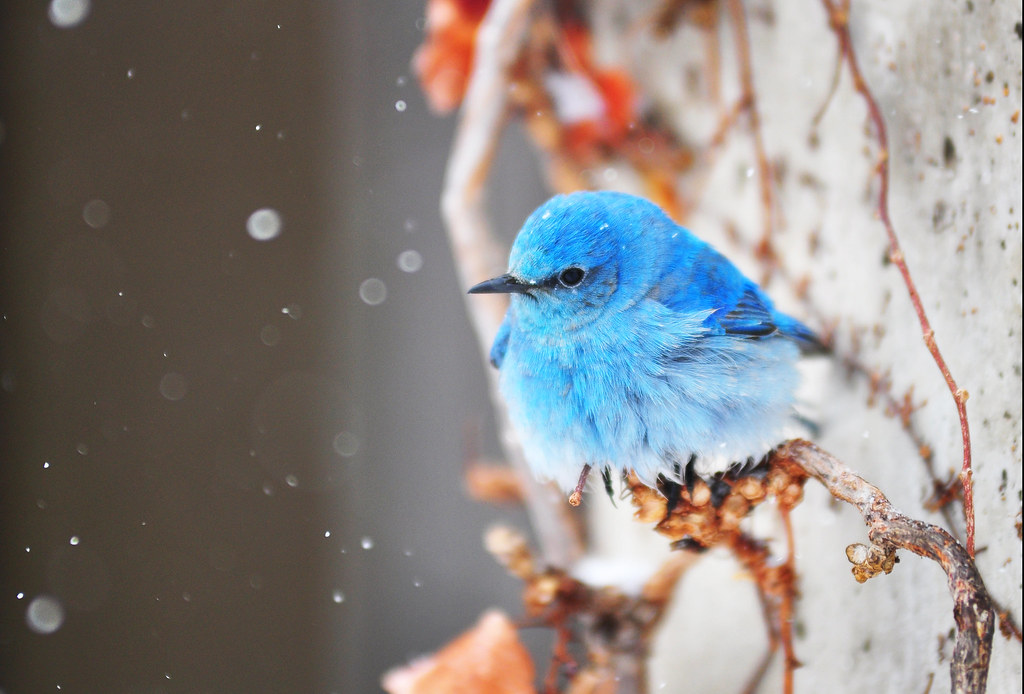The mountain bluebird (Sialia currucoides) is a small migratory thrush that is found in mountainous districts of western North America. It has a light underbelly and black eyes. Adult males have thin bills and are bright turquoise-blue and somewhat lighter underneath. Adult females have duller blue wings and tail, grey breast, grey crown, throat and back.



In fresh fall plumage, the female’s throat and breast are tinged with red-orange, brownish near the flank contrasting with white tail underparts. Their call is a thin ‘few’; while their song is warbled high ‘chur chur’. It is the state bird of Idaho and Nevada. It is an omnivore and it can live 6 to 10 years in the wild. It eats spiders, grasshoppers, flies and other insects, and small fruits. The mountain bluebird is a relative of the eastern and western bluebirds.

BASIC DESCRIPTION
Male Mountain Bluebirds lend a bit of cerulean sparkle to open habitats across much of western North America. You may spot these cavity-nesters flitting between perches in mountain meadows, in burned or cut-over areas, or where prairie meets forest—especially in places where people have provided nest boxes. Unlike many thrushes, Mountain Bluebirds hunt insects from perches or while on the wing, at times resembling a tiny American Kestrel with their long wings, hovering flight, and quick dives.

Find This Bird
In the right places it can be a snap to find Mountain Bluebirds, as they are not shy of humans and live in fairly open country. They sit in the open on perches such as treetops, fence posts, and power lines. In summer in rural areas and ranches, particularly at higher elevations, you can often find them simply by driving rural roads and eyeballing such potential perches. In forested areas, look for them in large openings, particularly if there are aspen in the vicinity (aspen is a key cavity-providing tree in western montane forests). In winter, search for areas with berry-laden junipers and watch for flocks of birds feeding on those berries. Mountain Bluebirds often mix with Western Bluebirds, American Robins, and Cedar Waxwings when taking advantage of such fruity abundance.


Facts
- Historically, the Mountain Bluebird depended for nest sites on forest tree cavities excavated by woodpeckers. Today, many Mountain Bluebirds breed in artificial nest boxes, which tend to be situated in more open areas and have smaller openings to keep out marauders and bad weather. Most of what we know about Mountain Bluebirds comes from studies of these human-made nesting sites.
- A female Mountain Bluebird pays more attention to good nest sites than to attractive males. She chooses her mate solely on the basis of the location and quality of the nesting cavity he offers her—disregarding his attributes as a singer, a flier, or a looker.
- A male Mountain Bluebird frequently feeds his mate while she is incubating and brooding. As the male approaches with food, the female may beg fledgling-style—with open beak, quivering wings, and begging calls. More often, she waits until her mate perches nearby, then silently flicks the wing farthest from him—a signal that usually sends him off to find her a snack.
- Mountain Bluebirds compete fiercely with other cavity-nesters over nest sites. Early spring arrival at nesting grounds, for example, helps them take possession of choice cavities before Tree Swallows can appropriate them. Northern Flickers sometimes enlarge the entrance holes of nest boxes before discovering the box is too small for their own use—rendering the boxes permeable to weather and competitors such as European Starlings.



